Your lawnmower is an underappreciated, modern-day workhorse.
The trusty 4 (or 2) wheeled companion doesn’t tire, moan or slack… it does what it’s supposed to, when it’s supposed to. It cuts grass like a knife through butter. A robust, reliable, and unrelenting mowing tour de force.
As with any feat of engineering, the more we tinker, the more we learn. Advancements in technology have led to a surge of lawnmower brands, each packed with unique features.
The choice may be huge, but investing in the right lawnmower will save you time, money and give you the perfect finish every time.
Don’t worry, we’re here to help.
History of Lawnmowers
A Brief History
Advancements in petrol and electric power in both the 19th century and 20th century proved instrumental for lawnmowers.
Although the late 19th century was overshadowed by Thomas Edison, Nikola Tesla and George Westinghouse’s AC/DC “battle of the currents”, the ongoing war was between petrol and electric.
English engineer Edwin Budding invented the first (manual) lawnmower in 1830 and it didn’t take long for his invention to become embroiled in the ensuing conflict.
Petrol & Diesel Power
1804 – Isaac de Rivaz, a Franco-Swiss inventor, develops the De Rivaz engine. Allegedly the first internal combustion engine in history.
1858 – Belgium engineer Étienne Lenoir develops the first two-stroke engine.
1870 – German inventor Siegfried Marcus mounts a combustion engine onto a cart. The first vehicle propelled by an engine.
1877 – Nikolaus Otto and a number of other German engineers patent the first practical 4-stroke engine.
1885 – Karl Benz (of Mercedes Benz) unveils the “Benz Patent-Motorwagen”, the first petrol propelled automobile.
1893 – Rudolf Diesel invents and patents the diesel engine.
1902 – British company Ransomes, Sims and Jefferies Limited invent the first petrol lawnmower.
1908 – Henry Ford unveils the Ford Model T, the first mass-produced and affordable automobile.
1968 – With pressure from western governments to limit emissions, Mercedes-Benz are the first manufacturer to swap from the traditional carburettor to Electronic Fuel Injection (EFI).
2016 – EFI technology starts to appear on lawnmowers and other handheld machinery.
Electric Power
1800 – Italian, Alessandro Volta, invents the first true battery.
1827 – Hungarian, Ányos István Jedlik, invents the dynamo and first electric motor.
1837 – Scottish scientist Robert Davidson creates the first battery-powered electric car.
1859 – The first rechargeable lead-acid battery is invited by Frenchman Gaston Planté.
1884 – Prolific English inventor Thomas Park unveils the first production electric car. Global engineers follow suit. Popularity soars and the golden age of electric vehicles begins.
1910 – Popularity of electric vehicles wanes as petrol engines become more efficient and fuel becomes cheaper.
1930 – Electric motors expand to lawnmowers.
1964 – First battery-powered lawnmower.
1969 – Concepts for the first robotic lawnmower appear.
1980 – American John B. Goodenough
Invents the Li-ion battery.
1994 – First battery-powered ride-on lawnmower.
2016 – A new range of 80V battery lawnmowers are unveiled, rivalling the performance of petrol.
Types of Lawnmowers
Types of Lawnmower
Investing in the right lawnmower will save you time, money and give you the perfect finish every time.
That being said, choosing which one is right is not so simple.
Luckily, we know our stuff.
User-propelled (Push)
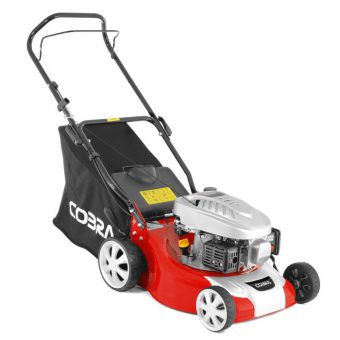 Pretty self-explanatory – the lawnmower moves as you push. You control the speed and direction, but maneuverability is limited due to the lack of a steering axle.
Pretty self-explanatory – the lawnmower moves as you push. You control the speed and direction, but maneuverability is limited due to the lack of a steering axle.
Either the motion of you pushing (manual lawnmowers only), an engine or an electric motor powers the blade.
Hover
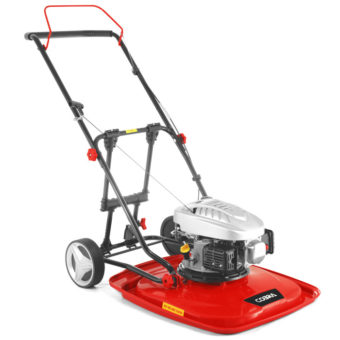 Similar to a hovercraft, a hover lawnmower creates a cushion of air between the lawnmower and lawn giving it
Similar to a hovercraft, a hover lawnmower creates a cushion of air between the lawnmower and lawn giving it
a gliding action.
Although this allows for more freedom while operating, they can still be quite heavy to maneuver.
They also do not collect grass clippings.
Self-propelled
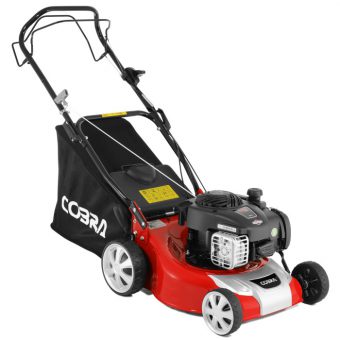 An engine or electric motor propels both the lawnmower and blade. Some self-propelled lawnmowers have a single speed, others, adjustable.
An engine or electric motor propels both the lawnmower and blade. Some self-propelled lawnmowers have a single speed, others, adjustable.
You control the direction, but maneuverability is limited due to the lack of a steering axle.
Ride-on
As the name suggests, there is no standing or walking required.
Ride-on lawnmowers are similar to cars in that they have a steering wheel, steering axle, pedal accelerator and pedal brake.
Some models are operated by a manual clutch and gearbox and some by an automatic-hydrostatic transmission.
There are four main types of ride-on lawnmowers:
Compact
The smallest and least powerful of ride-on lawnmowers.
Models in this range have basic features/functionality, smaller engines and shorter cutting blades.
Their engine is rear mounted, cutting deck/blade in the middle and the grass clipping basket/compartment rear as well (just behind the engine).
Lawn Tractors & Garden Tractors
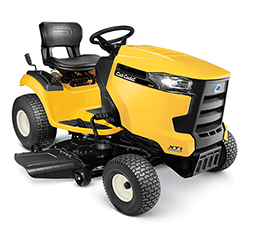 Lawn tractors and garden tractors are bigger and require more space to store.
Lawn tractors and garden tractors are bigger and require more space to store.
Their engine is front mounted, cutting deck/blade in the middle and the grass clipping basket/compartment rear mounted.
Basically a miniature farm tractor, they are robust and powerful enough to mow, as well as plough snow and tow trailers, scarifiers and rollers.
Zero-turn
 With a rear-mounted engine and wheels that allow for a 360° turning, these ride-on lawnmowers offer maximum manoeuvrability.
With a rear-mounted engine and wheels that allow for a 360° turning, these ride-on lawnmowers offer maximum manoeuvrability.
They are suited to gardens or lawns that are more intricate or complex in shape, or that have obstacles such as flower beds etc to navigate.
Out-front Decks
Also with a rear-mounted engine, these ride-on lawnmowers are unique in that they have a front-mounted cutting deck/blade.
They allow you to cut to the outermost extremities of a lawn/garden, or as close as possible to an obstacle.
This means that they are great for cutting underneath benches, tables and low hanging tree branches.
Robot
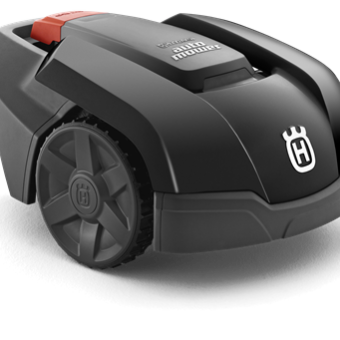 Once set up, robot lawnmowers work on their own.
Once set up, robot lawnmowers work on their own.
They trim a designated area intermittently and return to their base station when not in use, to charge, or for shelter from the rain.
They also do not collect grass clippings.

Power
Are modern corded and cordless lawnmowers finally advanced enough to depose the long-reigning king of power – fossil fuel, ushering in an age of electrical garden dominance?
Well, electric lawnmowers are certainly as – if not more – powerful than petrol, are cheaper and better than the environment.
So, what’s the catch? We’ll explain below.
Petrol
There are not that many diesel lawnmowers on today’s market. In the past, diesel engines were more economical, but with fuel prices now similar and petrol engines more efficient, they provide little advantage.
Most petrol lawnmowers have either a 1 or 2 cylinder, 4-stroke internal combustion engine.
Engine capacity is measured in cubic centimetres (CC) and energy output in horsepower (HP). Typically, the higher each of these numbers, the more power it provides.
To house the engine and mechanical parts, petrol lawnmowers are built quite robustly.
If you choose a model with a bigger engine, the housing and chassis will generally be bigger as well. Certain models have more than one engine choice.
Petrol engines require annual servicing in order to work effectively. Regular maintenance also improves product lifespan.
Because they are quite noisy and have some emissions, they can be a nuisance to neighbours, especially if you have a small garden.
The main strength of petrol lawnmowers is that they are great for remote areas.
You don’t have to worry about a cord getting in the way and unlike electric cordless (battery) lawnmowers, petrol can be stored in a jerry can to top up the lawnmower as and when is needed.
Internal Combustion Engine
Although an engine is made up of many different components, the critical parts are the: carburettor, cylinder, piston, flywheel, crankshaft, inlet/outlet valve and spark plug.
As the name suggests, these engines have 4 cycles to a stroke:
Inlet – a valve opens allowing a mixture of air and fuel to enter from the carburettor.
Compression – the intake valve closes and a piston compresses the mixture.
Power – magnets on the flywheel provide the spark to the spark plug. The spark plug ignites the mixture, releasing energy.
This turns the crankshaft and flywheel both creating propulsion and keeping everything in motion for the next cycle.
Outlet – a valve opens to allow spent gases to leave.
Rinse and repeat.
Electronic Fuel Injection (EFI)
Early petrol car engines were fitted with carburettors – which produced a lot of harmful emissions.
In the 1970/80s, with demand for petrol cars on the rise, the UK government had to find a way to limit the growing source of pollution.
They outlined a commitment to reducing total emissions by 80% by the year 2050.
Carbon budgets were put in place to restrict the amount of greenhouse gas produced over a five year period.
EFI was suggested as a solution. It has lower emissions and provides a much cleaner burn than that of a carburettor.
By the 1990s, most production cars had adopted EFI, but the majority of lawnmowers continued to use carburettors… until recently.
Benefits of EFI:
Better fuel efficiency/less fuel required (reduces fuel consumption by up to 25% in some cases).
Exhaust emissions are cleaner.
Lower emissions as a whole.
Although more expensive to buy than their carburettor counterpart, lawnmowers with EFI are much more efficient and will save you money in the long run.
Electric
There are two types of electric lawnmower: mains (corded) and battery (cordless). Both types are powered by electric motors.
As well as performing just as effectively (if not better) than internal combustion engines, electric also offers a few more benefits:
Need minimal maintenance.
Quieter.
Have zero emissions.
More compact.
Less expensive to run.
As they are quiet and have zero emissions, they
are perfect for the environmentally conscious business
or homeowner.
Because electrons travel much faster along a wire than fuel does along a fuel line, electric motors have a quicker response time and greater torque.
When generating torque, a petrol engine starts low and gradually increases. Electric motors can create maximum torque almost instantly.
Similar to “CC” and “HP”, an electric lawnmower’s power is measured in watts (W). Typically, the higher this number, the more power it provides.
Corded electric lawnmowers require a nearby socket, so are not recommended for people requiring unrestricted movement or are working in a remote area.
The cable also presents a health and safety risk as it can get in the way of cutting.
Electric cordless models use rechargeable lithium-ion batteries. Their capacity is measured in amp-hours (Ah) or watt-hours (Wh).
Typically, the higher these numbers, the longer a single charge will last.
With cordless, you don’t have to worry about a cord getting in the way and can work in remote areas. But, you do have to consider the charge of the battery.
Tackling tough grass will drain the battery quicker and as it loses charge, it will lose power/performance.
Unlike petrol, which can be stored in a jerry can, you cannot recharge a battery without a power outlet, so it is advisable to purchase a spare battery or two.
Brushed & Brushless Motors
A brushed motor is made up of four basic parts: carbon brushes, a ring of magnets, an armature, and a commutator.
A charge travels from the battery, through the brushes and into the commutator.
The commutator then passes the charge to the armature (made up of copper wire coils or windings).
Magnetized, the armature pushes against the ring of magnets that surround it and forces the assembly to spin.
As it rotates, current is routed to different sets of windings which maintain the magnetic repulsion/attraction making the rotor continually turn.
A brushless motor has a small circuit board instead of the brushes and commutator, and different positions for the magnets and armature.
Brushless motors are more efficient, but more expensive than that of brushed.
Manual
Manual lawnmowers are the cheapest option as they have no engine or motor.
You provide the propulsion which in turn rotates the blade.
Because of their unique mechanism of action, you can only get manual lawnmowers with a cylinder blade, not rotary.
They are portable, easy to store, require minimal maintenance, quiet, have zero emissions and great for someone wanting a workout!
That being said, they are by far the weakest of the three power types.
Which Is Cheaper to Run?
Technically, a manual lawnmower would be the cheapest option overall as there are no ongoing power/fuel overheads. But, because of their limitations when compared with petrol or electric models, they have been excluded from this comparison.
Between petrol and electric… Well, how long is a piece of string?
When calculating running costs, there are a number of influencing factors you have to consider.
Things like petrol/electric prices, the frequency of use, duration of use, the type of grass you are cutting, how the lawnmower is stored, whether the lawnmower has been serviced, the fuel you use, the charger/battery you use etc – all need to be considered.
The average price of petrol in the UK: £1.20 per litre.
The average price of electricity in the UK: £0.13 per kWh.
(Prices accurate at the time of publication).
As an example, take a top of the range electric cordless lawnmower with a 1500w motor and an 80v battery, and a petrol lawnmower of equivalent performance (excluding ride-on lawnmowers) with a 195cc engine and a 1l fuel tank.
If all the influencing factors were the same/consistent, a full, single charge of the 80v battery would cost just under 20p. So theoretically, you could get six full charges to one tank of petrol.
Electric/battery power is cheaper in the long run but more expensive initially, as essentially, you are buying the fuel upfront (battery cells just need recharging).
